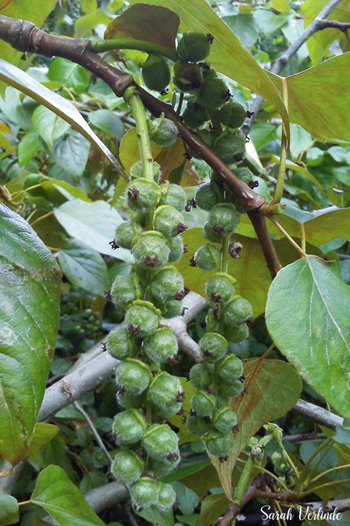Black cottonwood
Populus trichocarpa – Black cottonwood
Formerly: Populus balsamifera spp. trichocarpa
At a Glance:

- Family: Salicaceae
- Plant Type: deciduous, tall, erect tree
- Distribution: Widely distributed tree in western North America, Alaska to California, as far east as North Dakota.
- Habitat: In Washington state, this tree can be found along wetlands, streambanks, lake shores, and moist woods.
- Height: 50 meters tall
- Flowers/Fruits: drooping catkins. Males are green to red, females are green/pale yellow.
- Flowering Season: April – June
- Leaves: leathery/waxy dark green upper surface, with a lighter green underside. Leaf shapes can vary between diamond or heart-shaped with a finely serrated margin.
- Generation: Perennial
- Bark: Mature bark is brown and rugged and looks similar to Douglas-fir’s bark.
- Notable feature: The winter buds are yellow-brown and very pointed. They are covered in a resinous substance that is perfumed and smells like balsam. During the late spring, seeds are released in the wind with fine hairs.
Restoration and Conservation
Black cottonwoods are very fast growing and are easy to propagate with stem cuttings. The root systems help stabilize the soil, which is especially important for the restoration and conservation of riparian (river) areas they are commonly found growing in. Black cottonwood’s have a high nitrate uptake making them useful tools for buffering agricultural areas.
Ethnobotany
Black cottonwood resin has disinfectant properties and has been used by Coast Salish people for sore throats and coughs as well as being applied directly to wounds to prevent infection. The more tender inner bark was used for food in the spring and summer, and old dead leaves were boiled and used in baths to treat body aches and stomach problems. The black cottonwoods are still used commercially for particle board, plywood and veneer.
References and Resources
- Calflora: http://www.calflora.net/bloomingplants/blackcottonwood.html
- Pojar, J and MacKinnon, A. 2004. Plants of the Pacific Northwest Coast: Washington, Oregon, British Columbia and Alaska. Vancouver (BC): Lone Pine Publishing.
- USDA: https://plants.usda.gov/plantguide/pdf/cs_pobat.pdf
- WTU Image Herbarium: http://biology.burke.washington.edu/herbarium/imagecollection/taxon.php?Taxon=Populus%20trichocarpa
This article was written by Jessica Rouske and Sarah Verlinde. For questions regarding the UWB/CC Plant Tour, contact Sarah at severlin@uw.edu.
